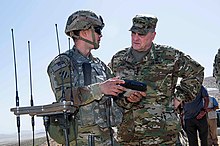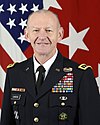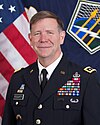The United States Armed Forces are the military forces of the United States. The armed forces consist of six service branches: the Army, Marine Corps, Navy, Air Force, Space Force, and Coast Guard. All six armed services are among the eight uniformed services of the United States.

The United States Army Space and Missile Defense Command (USASMDC) is the Army Service Component Command (ASCC) for United States Strategic Command and United States Space Command. It was established in 1985 as the Army Strategic Defense Command, responsible for ballistic missile defense. In 1992, it merged with Army Space Command to become Army Space and Strategic Defense Command. In 1997, it became an Army Major Command and was redesignated Army Space and Missile Defense Command.

Fort Eisenhower, formerly known as Fort Gordon and Camp Gordon, is a United States Army installation established southwest of Augusta, Georgia in October 1941. It is the current home of the United States Army Signal Corps, United States Army Cyber Command, and the Cyber Center of Excellence as well as the National Security Agency/Central Security Service' Georgia Cryptologic Center. It was once the home of the Provost Marshal General School and Civil Affairs School. Fort Eisenhower is one of the largest US Army installations in the world with more than 16,000 military service members and 13,500 civilian personnel assigned to it.

Second Army was most recently located at Fort Belvoir, Virginia as a Direct Reporting Unit to Headquarters U.S. Army, Chief Information Officer (CIO)/G-6. Under the CIO/G-6, Second Army served as the single point of contact for Army missions and functions related to reporting on, assessing, planning, coordinating, integrating, synchronizing, directing and conducting Army network operations. This mission ended after a 2017 reorganization, when the Second Army was deactivated.

The reorganization plan of the United States Army was implemented from 2006 to 2016 under the direction of the Brigade Modernization Command. This effort formally began in 2006 when General Peter Schoomaker was given the support to move the Army from its Cold War divisional orientation to a full-spectrum capability with fully manned, equipped and trained brigades; this effort was completed by the end of 2016. It has been the most comprehensive reorganization since World War II and included modular combat brigades, support brigades, and command headquarters, as well as rebalancing the active and reserve components.
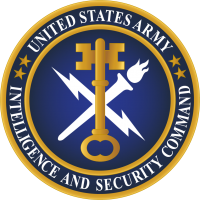
The United States Army Intelligence and Security Command (INSCOM) is a direct reporting unit that conducts intelligence, security, and information operations for United States Army commanders, partners in the Intelligence Community, and national decision-makers. INSCOM is headquartered at Fort Belvoir, Virginia.
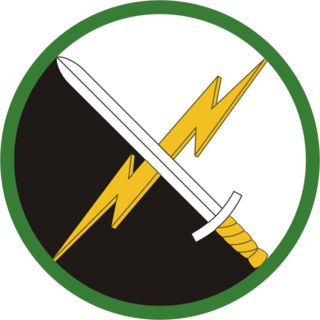
The 1st Information Operations Command (Land), formerly the Land Information Warfare Activity Information Dominance Center (LIWA/IDC), is an information operations unit under the operational control of U.S. Army Cyber Command (ARCYBER) and headquartered at Fort Belvoir, Virginia.

The 528th Sustainment Brigade (Airborne), 528th Sustainment Brigade (SO) (A), or 528th SB (SO) (A) was activated on 16 December 2008, as part of the overall United States Army Special Operations Forces logistics transformation. The brigade replaced the Special Operations Support Command (Airborne) (SOSCOM) as combat service support and combat health support unit for all Army Special Operations Command (USASOC) units under the 1st Special Forces Command (Airborne).

Twenty-Fourth Air Force / Air Forces Cyber (AFCYBER) was a Numbered Air Force within the United States Air Force. The Air Force consolidated its cyberspace combat and support forces into 24 AF. 24 AF was the Air Force component of U.S. Cyber Command.
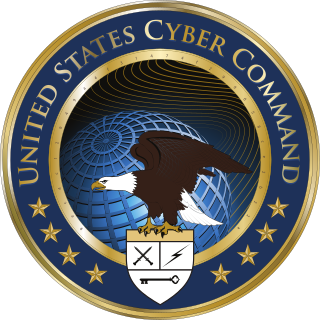
United States Cyber Command (USCYBERCOM) is one of the eleven unified combatant commands of the United States Department of Defense (DoD). It unifies the direction of cyberspace operations, strengthens DoD cyberspace capabilities, and integrates and bolsters DoD's cyber expertise which focus on securing cyberspace.

The structure of the United States Army is complex, and can be interpreted in several different ways: active/reserve, operational/administrative, and branches/functional areas.

United States Army Network Enterprise Technology Command (NETCOM) is a US Military unit subordinate to United States Army Cyber Command. NETCOM's mission is to operate and defend the computer networks of the United States Army. The numerical command for NETCOM was 9th Army Signal Command, though this distinction was removed on 1 October 2011. Its heritage can be traced back to the creation of the 9th Service Company in 1918. The command headquarters is at Fort Huachuca, Arizona. Major General Christopher L. Eubank assumed command in April 2022.

The U.S. Marine Corps Forces Cyberspace Command is a functional formation of the United States Marine Corps to protect critical infrastructure from cyberattack. Marine Corps Forces Cyberspace Command is the Marine Corps component to U.S. Cyber Command. It comprises a command element, the Marine Corps Cyber Operations Group, and the Marine Corps Cyber Warfare Group, a total of approximately 800 personnel. MARFORCYBER was established on January 21, 2010 under the command of LtGen George J. Flynn,. As of 7 July 2021, MajGen Ryan P. Heritage is in command.

U.S. Army Lieutenant General Alan R. Lynn was the Director, Defense Information Systems Agency at Fort Meade, MD.

The 780th Military Intelligence Brigade conducts cyberspace operations to deliver effects in support of Army and Joint requirements. The 780th MI BDE is the only offensive cyberspace operations brigade in the U.S. Army.

Lieutenant General Rhett Anthony Hernandez is a retired officer in the United States Army and the former commander of the United States Army Cyber Command, the Army's service component to United States Cyber Command. Hernandez assumed the position upon its activation on October 10, 2010, with its headquarters at Fort Belvoir, Virginia.

Gary Wayne Johnston (October 21, 1964 – January 20, 2022) was a United States Army major general who last served as the commanding general of the United States Army Intelligence and Security Command (INSCOM) from June 2018 to July 2021. As commander of the direct reporting unit, he served as the overall mission commander for the Army's 17,500 operational intelligence forces and a key source of logistics and support to the United States Intelligence Community. Prior to leading INSCOM, he held various roles in Army intelligence supporting U.S. operations in primarily Southwest Asia.

The United States Army Geospatial Intelligence Battalion, previously known as the 3rd Military Intelligence Center, is a military intelligence battalion specializing in the production and exploitation of geospatial intelligence (GEOINT), and the only operational military command at the National Geospatial-Intelligence Agency (NGA). Co-located within the NGA headquarters (NGA-East) on Fort Belvoir in Springfield, Virginia, the unit produces and analyzes geospatial intelligence products for ground combat forces in close collaboration with its host agency and other members of the U.S. Intelligence Community. Though colocated with NGA, the AGB differs from NGA's own Support Teams in that it receives tasking from the Army.
The 56th Theater Information Operations Group is a brigade-sized command of the United States Army National Guard based in Washington, and Maryland. In 2015 it took on the additional role as a major subordinate command in the Washington Army National Guard, aligning military intelligence and special operations forces under its command for administrative control.


